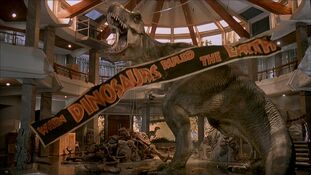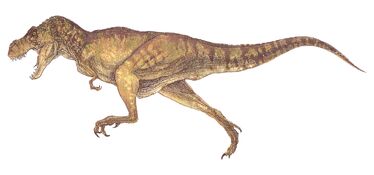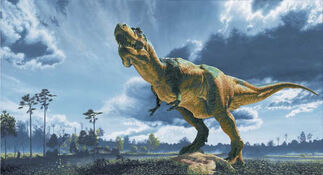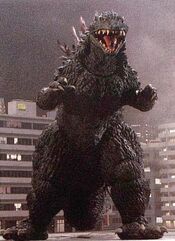Tyrannosaurus rex (pronounced tie-RAN-oh-SOR-us REX) is a non-avian tyrannosaurid theropod dinosaur that appeared roughly 68 million years ago and went extinct in the K-T extinction, about 66 million years ago in North America. Tyrannosaurus is one of the heaviest land predators of all time, and is the largest known land predator ever to roam the Northern Hemisphere, among meat eating dinosaurs.
Size[]
The overall size of Tyrannosaurus is somewhat debated, but the most dependable estimates put it in the 40 foot (12 meters), 7-9 ton (14,000 focus 18,000 lbs.) range. The most complete Tyrannosaurus specimen, FMNH PR 2081 (nicknamed 'Sue', after her discoverer, Sue Hendrickson) measures 40 feet (12.3 meters) in length and is 13 feet (4 meters) tall at the hips.
The lowest size estimates for T. Rex are about 36-37 feet (11-11.3 meters) in length and 5 tons (10,000 lbs.) in weight. Some specimens including Thomas, Devil Rex, C-Rex, F-Rex, and UCMP 118742 shows possibilities of even larger size than Sue. Some have even been estimated to be 13 meters (43 ft) in length! The problem with these specimens is, they are very fragmentary (incomplete); thus showing inconclusive evidence.
However the biggest and oldest T. Rex, Scotty would have Weighed around 9 - 10 tons (18,000 - 19,555 pounds), been 13 meters (43 ft) long and lived into his early 30s. Death cause possibilities due to injuries ranging from broken ribs to an infected jaw.
[]
[]

T.rex compared with an average sized Human.
Hunting and Diet[]
The question of whether T. Rex was a hunter or scavenger has been the subject of debate for decades, though most scientist today agree that T. Rex was most likely an opportunistic predator: hunting when necessary, and scavenging when given the opportunity. A hypothesis by Philip Currie suggests that T. Rex hunted in packs, where the agile juveniles would chase prey right into the jaws of the larger, more powerful adults. Currie's hypothesis however has been criticized by the scientific community due to it's lack of solid evidence in the fossil record.
Tyrannosaurus' prey on large herbivores like Edmontosaurus, Anatosaurus to Triceratops, Torosaurus, Ankylosaurs, young Alamosaurus, and practically any animal in its environment, that it could get its jaws on. Young Tyrannosaurus had to compete with Dakotaraptor, and Alamotyrannus, but the later is controversial as it may be a distinct genus or just a synonym of Tyrannosaurus.
Integument[]
While early Tyrannosaurs such as Dilong and Yutyrannus are known to have had feathers as adults, it is also reasonable to assume that T. Rex (and other large Tyrannosaurs) may have had feathers. Multiple theories suggest that juvenile T. Rex had feathers, but lost them upon reaching maturity. However, this could be proven otherwise due to the fact that Yutyrannus (a large Tyrannosaur) sports feathers. With the usage of phylogenetic bracketing, we can safely say that Tyrannosaurus Rex may have had feathers but how much the feathers cover is unknown.

An infograph explaining the possible integument of T.rex.
Hell Creek's annual temperature was around 7 to 11 degrees Celsius during the dry season; around the same temperature as the Liaoning Province that Yutyrannus lived 61 million years earlier. The temperate area during the dry season would have allowed Tyrannosaurus to have a coating of feathers without overheating since feathers can insulate heat for the animal during such time. Yet, there are some reasons to suggest that T-Rex would most likely be covered in scales as animals stop receiving any benefit from dermal insulation at somewhere between 1 and 3 tons. Due to the costs of producing such integument, this may cause these traits to be selected against, as has occurred in many large mammals with fur, like elephants, as stated in the game SAURIAN with there T-Rex redesign.☀https://sauriangame.squarespace.com/blog/2018/9/20/tyrannosaurus-redesign-2018
Speed[]
Tyrannosaurus' speed is a heavily debated subject. Estimates as low as 5 mph have been suggested, as well as estimates up to 45 mph to even 70 km. The most generally accepted top speed for an adult T-rex is in the 15 - 20 mph range for a short period of time. However, juvenile T. Rex probably could've ran faster. Due to their shinbones (Tibia and fibula) being proportionately longer than their thigh (femur) bone accompanied by their long metatarsal bones (foot bones, that Lead into the actual phalanges) as juveniles, they could've achieved a top speed of an impressive 35 mph for short distances; slightly faster than Usain Bolt. Who's current speed record is 28.7 mph. Nevertheless, the adult T-rex was built for distance, not speed and optimized for energy-efficient walking like wolves and camels.
Arms[]
At 3 feet (1 meter) long, the arms of T. Rex are tiny compared to the animal's 40 foot body. Despite their small size, studies suggest that the arms of an adult T. Rex could lift some 200 - 450 pounds. Scientists are unsure about what the arms were used for; suggestions include mating, feeding, and combat. Whether or not T. Rex utilized its arms at all remains a mystery.
Bite Force[]
Tyrannosaurus had a skull reaching 1.3-1.5 m long. Its massive jaws were backed by huge muscles that allowed it to bite down with bone-crushing force. Minimally, Tyrannosaurus had a bite force of 1,800 pounds (816 kilograms) per square inch; with an estimated maximum bite exceeding 12,800 - 14,000 pounds (6.4 -7 tons) per square inch.

Computer model of T.rex's bite force
T. Rex has the strongest bite force of any land animal (other predators had bite forces comparable to or exceeding T. Rex's, such as mosasaurs, but they were mainly aquatic or semi-aquatic animals), ranking among one of the strongest in the animal kingdom.
In Popular Culture[]
Tyrannosaurus Rex is perhaps one of the most famous and feared dinosaurs ever to be discovered, and has been featured in many movies, books, documentaries, and TV shows. One of its most famous film Roles was in the widely popular Jurassic Park and now Jurassic World trilogy's. Scientific documentaries featuring T. Rex include When Dinosaurs Roamed America, Walking With Dinosaurs, Jurassic Fight Club and other dinosaurs movies. As well of in games Saurian, The Isle, Beasts of Bermuda, Jurassic World Evolution 1 - 2 and Prehistoric Kingdom and many other dinosaur games.
Gallery[]
























